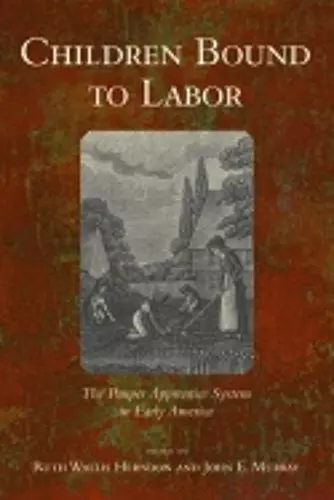Children Bound to Labor
The Pauper Apprentice System in Early America
Ruth Wallis Herndon editor John E Murray editor
Format:Hardback
Publisher:Cornell University Press
Published:10th Mar '09
Currently unavailable, and unfortunately no date known when it will be back
This hardback is available in another edition too:
- Paperback£28.99(9780801475597)

The history of early America cannot be told without considering unfree labor. At the center of this history are African and Native American adults forced into slavery; the children born to these unfree persons usually inherited their parents' status. Immigrant indentured servants, many of whom were young people, are widely recognized as part of early American society. Less familiar is the idea of free children being taken from the homes where they were born and put into bondage.As Children Bound to Labor makes clear, pauper apprenticeship was an important source of labor in early America. The economic, social, and political development of the colonies and then the states cannot be told properly without taking them into account. Binding out pauper apprentices was a widespread practice throughout the colonies from Massachusetts to South Carolina-poor, illegitimate, orphaned, abandoned, or abused children were raised to adulthood in a legal condition of indentured servitude. Most of these children were without resources and often without advocates. Local officials undertook the responsibility for putting such children in family situations where the child was expected to work, while the master provided education and basic living needs.The authors of Children Bound to Labor show the various ways in which pauper apprentices were important to the economic, social, and political structure of early America, and how the practice shaped such key relations as master-servant, parent-child, and family-state in the young republic. In considering the practice in English, Dutch, and French communities in North America from the mid-seventeenth century to the mid-nineteenth century, Children Bound to Labor even suggests that this widespread practice was notable as a positive means of maintaining social stability and encouraging economic development.
Contributors: Monique Bourque, Willamette University; Holly Brewer, North Carolina State University; Gillian Hamilton, University of Toronto; Ruth Wallis Herndon, Bowling Green State University; Steve Hindle, University of Warwick; Paul Lachance, University of Ottawa; Timothy J. Lockley, University of Warwick; Gloria L. Main, University of Colorado, Boulder; John E. Murray, University of Toledo; Jean B. Russo, Historic Annapolis Foundation; Jean Elliott Russo, independent scholar; Adriana E. van Zwieten, Biographical Dictionary of Pennsylvania Legislators; T. Stephen Whitman, Mount St. Mary's University
Ruth Wallis Herndon and John E. Murray have gathered together twelve fine essays in this volume that provides welcome insight into the varied apprenticeship practices on display in North America from the late seventeenth century through the mid nineteenth. Children Bound to Labor demonstrates that apprenticeship was a pervasive and remarkably flexible institution that could be adapted to fit divergent political and economic contexts in early America.
* Georgia Historical Quarterly *This excellent collection brings together a dozen essays that explore the history and significance of pauper apprenticeship (also known as orphan apprenticeship or binding out). Most of the essays are based on detailed research in the records and circumstances of particular communities; they focus on the eighteenth and early nineteenth centuries and range across North America, mainly in the British colonies but with interesting essays on New Netherland and Montreal as well. Taken together, these essays do much to advance our knowledge of the institution, and they make a convincing cases for its importance to our understanding of early American culture and development, including the central issues of labor, poverty, ideas about child rearing, society, and the state, and the effects of economic and social changes.
-- Helena M. Wall * Journal of Southern HistoISBN: 9780801446245
Dimensions: 235mm x 155mm x 24mm
Weight: 907g
280 pages